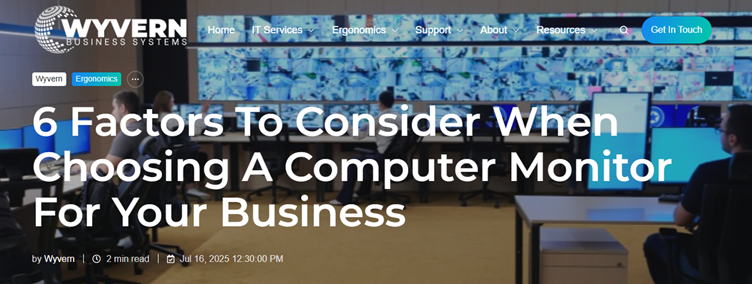Are you thinking about how to choose a computer monitor for your business? If we were to ask you what factors would go into making that decision, your response might be “I dunno”, or “Whatever’s cheapest, I guess”. After all, it’s just a monitor. Just another piece of operational expenditure. It can’t have that much of an impact on your business outcomes.
Can it?
You may be surprised to learn that not all monitors are created equal. Their sizes, resolutions, dimensions, ergonomic adjustability, and build quality can all make a modest but tangible difference to your business.
Here we’ll look at six factors to consider when choosing a computer monitor as part of your business hardware suite.
- Size And Resolution
Smaller, lower-resolution monitors can encourage users to squint or lean forward to get a clearer view of small details. This can lead to an increased risk of eye strain, neck strain and poor posture. By contrast, larger displays with higher resolutions (Full HD, QHD, or 4K) can boost productivity, providing a clearer view of subjects such as spreadsheets, design projects or mind maps. They also provide a greater space for multitasking.
There is a balance to be struck between available desk space and budget. However, better resolution and a larger size can often aid in comfortable, productive working.
- Panel Technologies
In many ways, knowing how to choose a computer monitor for your business is like choosing a TV for your home. You need to consider the panel technologies to ensure that you’re getting the best balance of colour accuracy, available viewing angles and response time for your needs and budget. While virtually all contemporary monitors belong to the LCD panel technology, there are numerous subcategories including IPS, TN, VA, and OLED.
Broadly speaking, IPS (In-Plane Switching) panels are typically best for office environments due to their clarity and consistent visuals from different angles. This allows users to get a clear view from an angle that is comfortable and suitable for them.
- Ergonomics
Speaking of viewing angles, when users have to crane their heads to look at monitors, this can lead to increased neck pain and poor posture, resulting in an increased risk of distraction or even more sick days.
Choose a monitor that employees can tilt, swivel, and adjust for height. This investment in long-term employee wellbeing not only shows your team that you care but also helps you with DSE compliance.
- Input And Output
Of course, monitors are not used on their own. Their connectivity to your existing tech stack can result in friction. Make sure you choose a monitor that supports both modern HDMI and legacy ports (e.g. DisplayPort, USB-C, VGA). This can ensure seamless integration into your IT architecture as well as helping you to future-proof your tech resources.
- Sustainability
At a time when business energy rates remain sky-high and climbing, choose a low-energy monitor. This can not only help you to cut electricity costs but also support your CSR and sustainability goals.
Look for certifications like EU Energy Labels, TCO Certified, or Energy Star. No one monitor will help you to drive down energy costs on its own, but in bulk they will help you to comply with efficiency and environmental standards while mitigating energy spending.
- Cost
Finally, while cost is not the only factor, it is almost certainly a significant factor for most buyers. Be sure to strike the right balance between short-term cost and long-term savings when factoring in monitoring spending into your budget.
Need help choosing the right monitors for your team? Speak to Wyvern Business Systems today, and we’ll help you find scalable hardware solutions tailored to your business needs!


